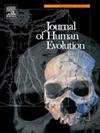限制日本猕猴和蜘蛛猴髋关节伸展运动范围的解剖学因素
IF 3.1
1区 地球科学
Q1 ANTHROPOLOGY
引用次数: 0
摘要
日本猕猴(Macaca fuscata)能够两足行走,但与人类行走有着根本的区别,包括四肢弯曲的姿势和单峰的地面反作用力轮廓。造成这些差异的一个关键因素是他们的髋关节伸展有限,可能受到肌肉结构的限制。本研究考察了日本猕猴和蜘蛛猴(Ateles spp.)髋关节伸展的解剖学限制,它们在两足行走时实现了更大的髋关节伸展。我们使用定制的测量装置测量了尸体标本中髋关节屈肌连续解剖前后的被动关节力矩,以量化不同肌肉群的被动髋关节阻力。我们的研究结果揭示了髋关节活动的物种特异性差异:日本猕猴对髋关节伸展表现出更大的被动阻力,主要是由于内收肌群和关节囊,而蜘蛛猴表现出更低的阻力,髂腰肌在限制髋关节伸展方面发挥了更大的作用。这些发现强调了被动弹性肌肉约束在灵长类动物两足动物形成中的作用,并为人类运动的进化提供了比较的见解。本文章由计算机程序翻译,如有差异,请以英文原文为准。
Anatomical factors restricting hip extension range of motion in Japanese macaques and spider monkeys
Japanese macaques (Macaca fuscata) are capable of bipedal locomotion but exhibit fundamental differences from human walking, including a flexed limb posture and a single-peaked ground reaction force profile. One key factor underlying these differences is their limited hip extension, likely constrained by muscle architecture. This study examines the anatomical restrictions on hip extension in Japanese macaques and spider monkeys (Ateles spp.), which achieve greater hip extension during bipedal walking. We measured passive joint moments before and after the sequential dissection of hip flexor muscles in cadaveric specimens using a custom-built measurement device to quantify passive hip joint resistance across different muscle groups. Our results reveal species-specific differences in hip mobility: Japanese macaques exhibit greater passive resistance to hip extension, primarily due to the adductor muscle group and joint capsule, whereas spider monkeys show lower resistance, with the iliopsoas playing a more substantial role in restricting hip extension. The findings emphasize the role of passive elastic muscle constraints in shaping primate bipedalism and offer comparative insights into the evolution of human locomotion.
求助全文
通过发布文献求助,成功后即可免费获取论文全文。
去求助
来源期刊

Journal of Human Evolution
生物-进化生物学
CiteScore
6.30
自引率
15.60%
发文量
104
审稿时长
3 months
期刊介绍:
The Journal of Human Evolution concentrates on publishing the highest quality papers covering all aspects of human evolution. The central focus is aimed jointly at paleoanthropological work, covering human and primate fossils, and at comparative studies of living species, including both morphological and molecular evidence. These include descriptions of new discoveries, interpretative analyses of new and previously described material, and assessments of the phylogeny and paleobiology of primate species. Submissions should address issues and questions of broad interest in paleoanthropology.
 求助内容:
求助内容: 应助结果提醒方式:
应助结果提醒方式:


